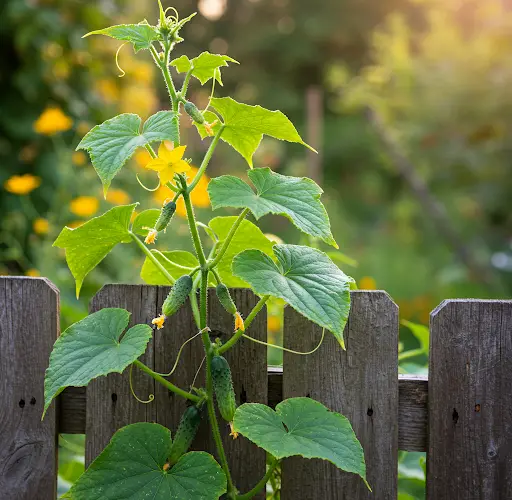Growing cucumbers at home is incredibly rewarding, especially when your plants are healthy, climbing freely, and loaded with fruit. One of the best ways to boost cucumber production in a home garden is by using a climbing trellis. This simple structure can significantly increase yields, improve air circulation, and save precious garden space—all while making harvesting easier and cleaner.
Whether you’re growing cucumbers in the ground, in containers, or on a small balcony, a trellis is a smart, affordable solution that supports healthy growth and maximizes fruiting potential.
Why Cucumbers Need a Trellis
Cucumber plants are natural climbers. In their native environment, they sprawl across the ground or climb over nearby vegetation. In a home garden, however, letting them sprawl can waste space and increase the risk of diseases and pests. A trellis helps in several ways:
-
Keeps fruits off the ground, reducing rot and pest damage
-
Improves air circulation, helping prevent fungal infections
-
Saves space, making it ideal for small gardens or containers
-
Increases exposure to sunlight, promoting healthier vines
-
Eases harvesting, as fruits are easier to see and pick
The result is healthier plants and more abundant harvests.
Choosing the Right Spot
Before building a trellis, choose a location that gets at least 6 hours of sunlight per day. Cucumbers love the sun and thrive in warm, bright areas. The spot should also have good air movement and be easily accessible for watering, pruning, and harvesting.
If you’re growing in containers, place the pots near a wall, railing, or open space where your trellis can be secured or leaned safely.
Materials You Can Use for a Cucumber Trellis
Building a trellis doesn’t require fancy materials. You can use both new and recycled items, depending on what you have available. Here are some practical options:
-
Wooden stakes or bamboo poles
-
Garden netting or chicken wire
-
Nylon string or twine
-
PVC pipes or metal rods
-
Recycled materials like old ladders, bed frames, or pallets
As long as the material is strong, weather-resistant, and provides climbing support, it can be used to build a functional cucumber trellis.
Simple DIY Trellis Ideas
Here are a few easy and popular trellis designs you can make at home:
1. A-Frame Trellis
-
Create an A-shaped frame using bamboo, wood, or PVC.
-
Secure netting, string, or wire between the sides.
-
Position over cucumber plants and allow them to climb both sides.
-
Bonus: The A-frame can be folded and stored easily when not in use.
2. Vertical Trellis on a Wall or Fence
-
Drive sturdy stakes into the ground.
-
Attach a vertical grid of string, netting, or metal wire.
-
Train the cucumber vines to grow upward along the structure.
This is a space-saving option ideal for balconies or patios.
3. Teepee or Tripod Trellis
-
Place three or four bamboo poles in the soil, angled toward each other to form a cone.
-
Tie them at the top with strong twine.
-
Wrap string or mesh around the structure in a spiral pattern for the vines to grip.
This method looks beautiful and functions well in tight spaces.
4. Arch Trellis
-
Bend metal conduit or flexible PVC pipes to create an arch.
-
Cover with netting or wire for the vines to climb.
-
Plant cucumbers at the base of each side.
This method is excellent for walk-through garden areas and creates a stunning, productive tunnel effect.
Training Cucumbers to Climb
Once the trellis is in place and your cucumber plants are growing, guide the vines toward the support structure. As they grow, use soft plant ties or strips of cloth to gently secure them to the trellis. The tendrils will naturally wrap around the structure as the plant climbs.
Regularly check and adjust the vines to keep them growing upward. This also helps you spot any issues early, such as yellowing leaves or pests.
Trellis Maintenance Tips
-
Check for stability after heavy winds or rain.
-
Repair broken parts promptly to avoid damaging plants.
-
Trim excess foliage to improve airflow and light exposure.
-
Clean the trellis at the end of the season if you’re reusing it next year.
A well-maintained trellis can be used for many growing seasons and adapted to other climbing plants like beans, peas, or tomatoes.
Harvesting Cucumbers on a Trellis
Trellised cucumbers are easier to harvest than ground-grown ones. The fruits hang down and are more visible, making it simple to find and pick them at the right time. For the best flavor and texture:
-
Harvest when cucumbers are firm and green
-
Avoid letting them overgrow, as they can become bitter or seedy
-
Pick regularly to encourage more fruit production
Final Thoughts
A climbing trellis is one of the simplest and most effective upgrades you can make to your cucumber-growing setup. It doesn’t require a lot of space or expensive materials, and it greatly improves the health, productivity, and beauty of your cucumber plants.
Whether you’re gardening in a small backyard or an apartment balcony, adding a trellis to your cucumber patch can lead to a bountiful harvest and a more organized, efficient garden.


